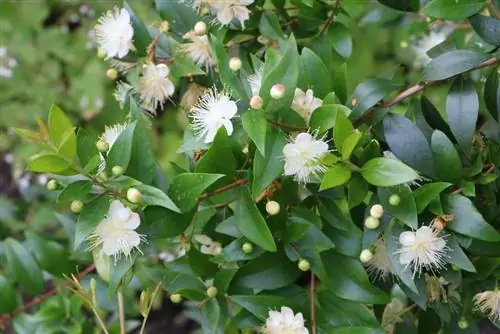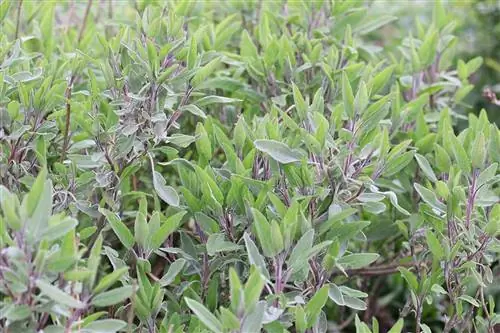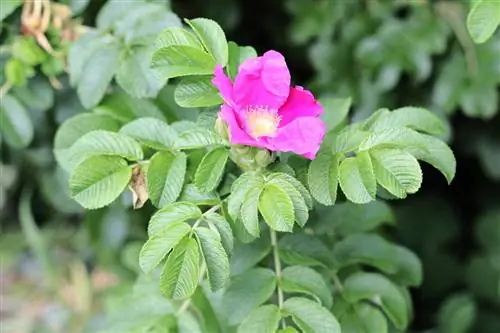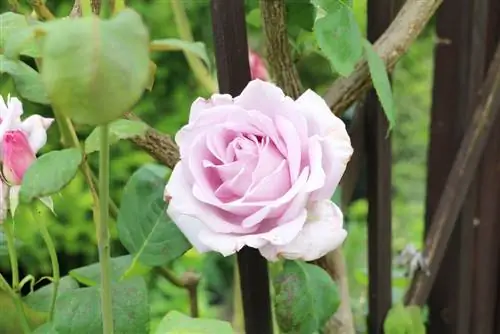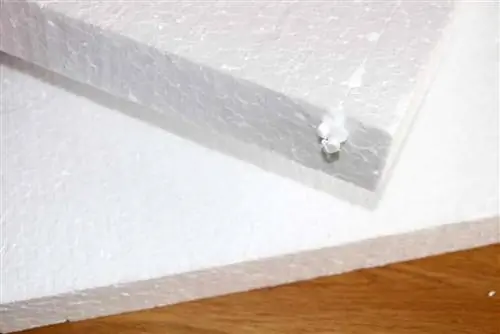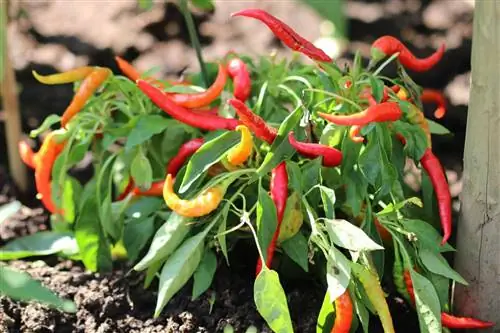- Author admin [email protected].
- Public 2023-12-17 03:39.
- Last modified 2025-01-24 12:45.
Many legends surround the bridal myrtle. According to legend, the Mediterranean plant adorned Aphrodite and was also extremely popular as an ornament among ancient Egyptian women. In our latitudes, myrtle was one of the classic ornamental and useful plants for centuries. What was once used as traditional wedding jewelry has not been forgotten thanks to passionate hobby gardeners. But the evergreen topiary is only partially suitable for beginners. Because the plant is extremely demanding and reacts sensitively to changes.
Location and substrate
The Mediterranean topiary prefers a location in full sun, which should, however, be protected from the weather. You can meet these requirements, for example, in the immediate vicinity of your home or on a covered terrace. Shady places not only damage the external appearance of Myrtus communis, but also increase its susceptibility to disease. The plant happily accepts a warm and bright location in the winter garden all year round. If the requirements and needs of the plant are optimally met, the evergreen tree can reach a height of over 2 meters. The soil should be rich in humus and poor in lime. To do this, mix conventional potting soil with humus. It is also important that the substrate is permeable and excess irrigation water can quickly flow away from the plant roots. You can achieve this, for example, by mixing a handful of small pebbles into the soil. These do not cause any damage to the tree itself, but ensure that the soil is evenly loosened. If you are not comfortable with this method, you can also get special soil mixed with expanded clay from specialist retailers.
Watering and fertilizing
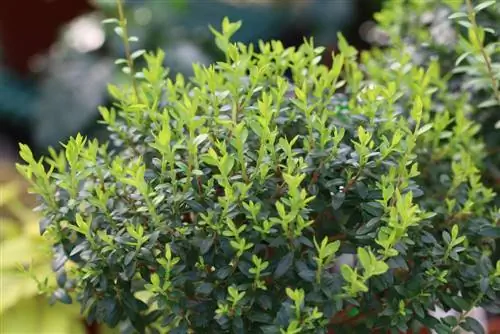
The bridal myrtle is not an ornamental tree that can be left to its own devices without hesitation. The evergreen plant reacts just as sensitively to waterlogging as it does to excessive dryness. Make sure that the plant's root ball does not dry out. Make your gardening and care work easier with a few simple tricks:
- Apply a thick layer of bark mulch underneath the tree.
- Ground-cover plants prevent the soil from drying out too quickly.
- Improve sandy soils with clay.
You can easily apply all of these tips to potted plants as long as the planter is large enough. Since myrtle can almost only be cultivated in pots in our latitudes, you should also add a layer of lava grit or pottery shards to the bottom of the pot. With this drainage you avoid standing moisture. Watering is carried out as soon as the top layer of substrate feels noticeably dry. Do not neglect the plant even in winter and check the soil regularly. Bride myrtles do not tolerate hard water. The lime content settles in the roots and slows down the absorption of the valuable liquid. However, you can safely water with rainwater. The supply of nutrients plays a minor role in the care of the Mediterranean plant. Nevertheless, with the right dosage you can promote the flowering power of the topiary. Fertilization takes place between March and August; you can choose to use a long-term or liquid fertilizer. The rule of thumb applies here: less is more. Even if potted plants quickly suffer from a lack of nutrients, you should never overdose on artificial fertilizers.
Tip:
Many problems with the tree occur due to irregular and incorrect watering. Loss of leaves can also be the first sign of standing wet or dry conditions.
Repotting
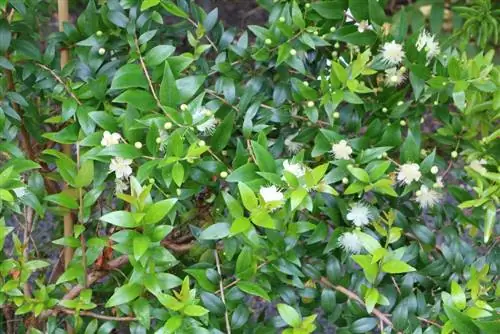
Approximately every 2 to 3 years or when the pot is completely rooted, you should treat the evergreen tree to a larger planter. However, a critical time for this measure is directly during the formation of the new buds. Loss of leaves or a complete absence of the next flower could be the result. Therefore, repot the plant in late summer, before the tree is moved to its winter quarters. First, generously free the myrtle from the old soil, while also removing any dead and dead root pieces.
- The new bucket should be at least 4 centimeters larger than the old container.
- A drainage made of porous material must also be created here.
- Apply a thick layer of substrate between the drainage and roots.
- Insert the plant and fill the cavities with soil.
- Pour vigorously.
Depending on the size of the Myrtus communis, it is advisable to have an extra pair of helping hands within reach. This way you avoid damage to the plant and make your work easier at the same time.
Propagate
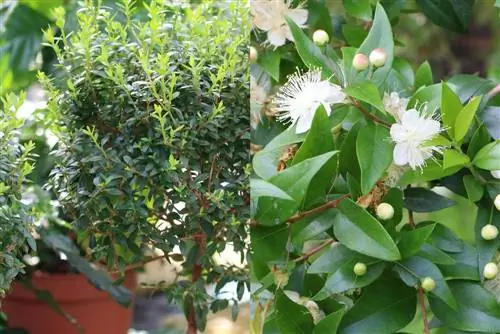
The cold-sensitive myrtle plant is propagated using slightly woody head cuttings. The well-ripened shoot ends are cut in spring or August.
- Short the cuttings to 10 to 15 centimeters.
- Remove the shoots except for the top three pairs of leaves.
- Place the cuttings in lean substrate.
- Keep soil evenly moist.
- Location must be bright and warm.
For quick and successful rooting of Myrtus, you can temporarily increase the humidity. If a transparent film doesn't work, place a sufficiently large glass container completely over the cutting. Remove the container for a few hours each day to prevent any rot from forming. As soon as the cutting develops new shoots and buds, it can be transplanted into humus-rich soil. Slowly acclimate the young plant to direct sunlight.
Cutting
Older shoots of bridal myrtle tend to become bald. These branches can be cut back heavily in spring with rose scissors or a sharp knife. The disadvantage of the campaign: The flower buds develop in autumn, so if you cut them back, the flowers may not bloom or be smaller. You can remove diseased and dead plant parts all year round. You can also use the slightly woody shoots that result from cutting to propagate the popular ornamental plant.
Wintering
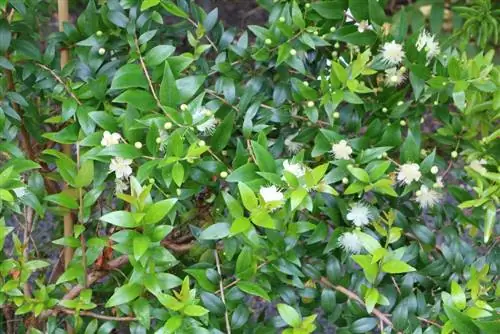
The plant with the dark green, egg-shaped leaves is extremely sensitive to frost. The original homeland of bridal myrtle is in the Mediterranean region. At the end of September at the latest, when the outside temperatures drop below 5°C, you should immediately move the tree into a bright, cool room. Avoid direct proximity to active radiators. If you want to put the plant back in the garden the following year, temperatures between 5 - 10°C are ideal for overwintering. Another important care measure in winter is the regular supply of water. Also, do not expose the plant to late frosts in spring. The cold temperatures are particularly hard on newly formed shoots and leaves. Especially with large specimens of Myrtus communis, temporarily moving the planter can pose a serious challenge to the hobby gardener. In such a case, you can also resort to a trick: Cover the entire plant with a light fleece.
Conclusion
Just a few decades ago, the myrtle bush could be found in almost every garden and could not be missing as a decorative accessory at any traditional wedding. Even though the popularity of the Mediterranean bridal myrtle has increased again in recent years, the plant is only of limited suitability, especially for beginner gardeners. The care requirements are high; the topiary reacts to the smallest mistakes by shedding leaves. However, if you successfully face this challenge, the evergreen plant will thank you with dark green, lush leaves and fascinating flowers.

